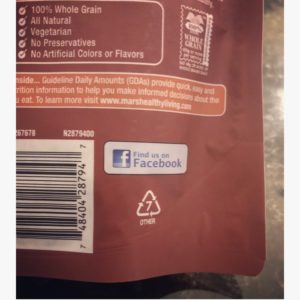Fast facts about plastics:
- Plastics are required to have a number listed on them to identify what chemicals they are made from.
- Temperatures, light, fat, acids and other ingredients can cause the chemicals in plastic to leach the items they come in contact with.
- The most toxic plastics are #3 (PVC), #6 (Styrofoam) and #7 (Other/BPA).
- Less toxic plastics include #1, #2, #4 and #5. (we strive to only use #5 when we MUST use plastic)
- Chemicals in plastics have been linked to obesity, hormone alterations, endocrine disturbances, type 2 diabetes, birth defects, developmental delays, early onset puberty, neurologic damage, systemic inflammation, cancer and more.
- 95% of all plastic products, regardless of their number, tested positive for estrogenic activity, meaning they can disrupt your hormones and even alter the structure of human cells.
10 ways to avoid toxic plastic exposures:
- Stop heating plastic. Ever. Do NOT put it in the microwave or oven. Do not serve hot food on plastic. Do not heat milk in a plastic bottle. Even the top rack of your dishwasher causes them to breakdown, they should be washed by hand with warm water only.
- Don’t use with acids or low pH: Think fruit, vinegar, dressings, water flavors, face creams. etc. Acids in foods and acidic chemicals in products can cause the plastic to degrade and leach into your food and beverages. Have you ever noticed water flavorings cause plastic bottles to get foggy? That’s because you are drinking the degraded plastic from the inside out! STOP!
- No fatty foods: Fatty foods bind with plastics because they are lipophilic. Have you noticed how hard it is to clean grease from plastic containers? The molecules are binding together and you can ingest them.
- Keep away from sunlight: Light can also cause plastics to break down, in a process called photodegradation. Keep them in dark cool places only.
- Swap out your plastic wrap: Use reusable wraps such as sheets of cotton coated in beeswax. You can also opt for wax paper or parchment paper secured with a rubber band. You could also try reusable silicone lids.
- Don’t cook or eat with plastic utensils: This includes spatulas, straws, whisks, beaters or on-the-go forks and spoons. When they touch heat, they leach chemicals into the foods you are cooking, eating or drinking.
- Use reusable food storage bags: Ziploc baggies are made from thin layers of plastic. Lunchskins Sandwich Bags are made with cotton, easy to clean and are reusable. You can also use silicone baggies, which have sturdy zippers and can be easily cleaned in the dishwasher.
- Opt for glass: Instead of plastic food storage containers, switch to glass. Also, use glass plates, bowls and cups.
- Use glass or stainless steel water bottles: This goes for your kids and babies too! Replace your bottle with a glass or stainless-steel version. Even if you use a reusable plastic bottle that states “BPA free”. Dump it!
- Skip the nonstick: Did you know that the nonstick coating on pots and pans is actually plastic? Instead of nonstick, choose cast iron or stainless steel so you can cook plastic free!
Knowing Your Plastics

#1: Polyethylene Terephthalate (PET) – PET is considered safe, but it can leach the toxic metal antimony and bromine which is used during its manufacturing. One study found that the longer a bottle of water sits on a shelf the greater the dose of antimony present. Bromine is known to act as a central nervous system depressant, and can trigger a number of psychological symptoms such as acute paranoia and other psychotic symptoms.
#2: High Density Polyethylene (HDPE) – HDPE, which is considered a low-hazard plastic. HDPE (like most plastics) has been found to release estrogenic (hormone altering) chemicals.
#3: Polyvinyl Chloride (PVC) – PVC plastic can be rigid (like water pipes) or flexible. PVC contains toxic chemicals including DEHP, a type of phthalate. Phthalates are one of the groups of “gender-bending” chemicals causing males of many species to become more female. These chemicals disrupt the endocrine systems of wildlife, causing testicular cancer, genital deformations, low sperm counts and infertility in several species, including polar bears, deer, whales and otters. PVC flooring has been linked to chronic diseases in children including allergies, asthma and autism.
#4: Low Density Polyethylene (LDPE) – Another plastic that is considered a low hazard. Studies show it may pose risks of leaching estrogenic chemicals, similar to HDPE.
#5: Polypropylene (PP) – Polypropylene is said to have a high heat tolerance making it unlikely to leach chemicals. However, it has been shown to leach small amounts of at least two of its chemical constituents when heated to high levels.
#6: Polystyrene (PS) – Polystyrene, also known as Styrofoam. Polystyrene is known to leach styrene, which can damage your nervous system and is linked to cancer. Temperature has been found to play a role in how much styrene leaches from Styrofoam containers, which means using them for hot foods and beverages (such as hot coffee) is most dangerous.
#7: “Other” – This is a catch-all designation used to describe products made from other plastic resins not described above, or those made from a combination of plastics. It’s difficult to know for sure what types of toxins may be in #7 plastics, but there’s a good chance it often contains BPA or the new, equally concerning chemical on the block in the bisphenol class known as Bisphenol-S (BPS).
BPA and BPS are endocrine disrupters, which means they mimic or interfere with your body’s hormones and “disrupts” your endocrine system. The glands of your endocrine system and the hormones they release are instrumental in regulating mood, growth and development, tissue function, metabolism, as well as sexual function and reproductive processes.
Some of the greatest concern surrounds early-life, in utero exposure to bisphenol compounds, which can lead to chromosomal errors in your developing fetus, causing spontaneous miscarriages and genetic damage. But evidence is also very strong showing these chemicals are influencing adults and children, too, and leading to decreased sperm quality, early puberty, stimulation of mammary gland development, disrupted reproductive cycles and ovarian dysfunction, cancer and heart disease, among numerous other health problems.
For instance, research has found that “higher BPA exposure is associated with general and central obesity in the general adult population of the United States,” while another study found that BPA is associated not only with generalized and abdominal obesity, but also with insulin resistance, which is an underlying factor in many chronic diseases. (Cited Here)

Sneaky items with BPA:
- Lining of nearly all canned food and soda
- Baby formula containers
- Glass canning jar lids
- Toothbrushes and toothpaste tubes
- Plastic lunchboxes
- Some baby pacifiers
- Some plastic toys
- Dental sealants and composite fillings
- Cash register receipts
- Some food containers (such as “steamable” bags as seen above)
- Water bottles
- Cardboard liquid containers such as juice boxes
The takeaway is to always look at the plastic number when reaching for something housed in plastic. Whenever possible, choose non-plastic alternatives. Is it possible to avoid all plastic exposures in today’s world? Of course not, but limiting daily exposures is key. An easy place to start is by replacing one item at a time and make the transition gradual. Mindfulness is key!
If you want tips on how to reduce other daily toxic exposures check out the rest of my website attached to this blog.

